
Forestrike is an action-roguelike and 2D fighting game that centers itself around a simple mechanic, Foresight, which allows players to replay fights as many times as they want before the real battle. The catch? You only have enough health to survive three consecutive hits. The devs over at Skeleton Crew Studios have cooked up a stylish and unique game, but it struggles to balance its risk vs reward gameplay.
Starting with the story, players take the role of Yu, a humble yet honed disciple of the Order of Foresight. Returning from his travels in the East, Yu must make his way back to the countryside monastery where the order resides. Our protagonist is soon hassled by drunken peasants, who are hunting down order members, but by using Foresight, we can make quick work of these bandits. The combat is pretty basic on the surface, with players having a light attack, a heavy attack, and the ability to pick up and throw objects. On top of that, players can dodge and block, but only under certain conditions, which we’ll get into in a second.
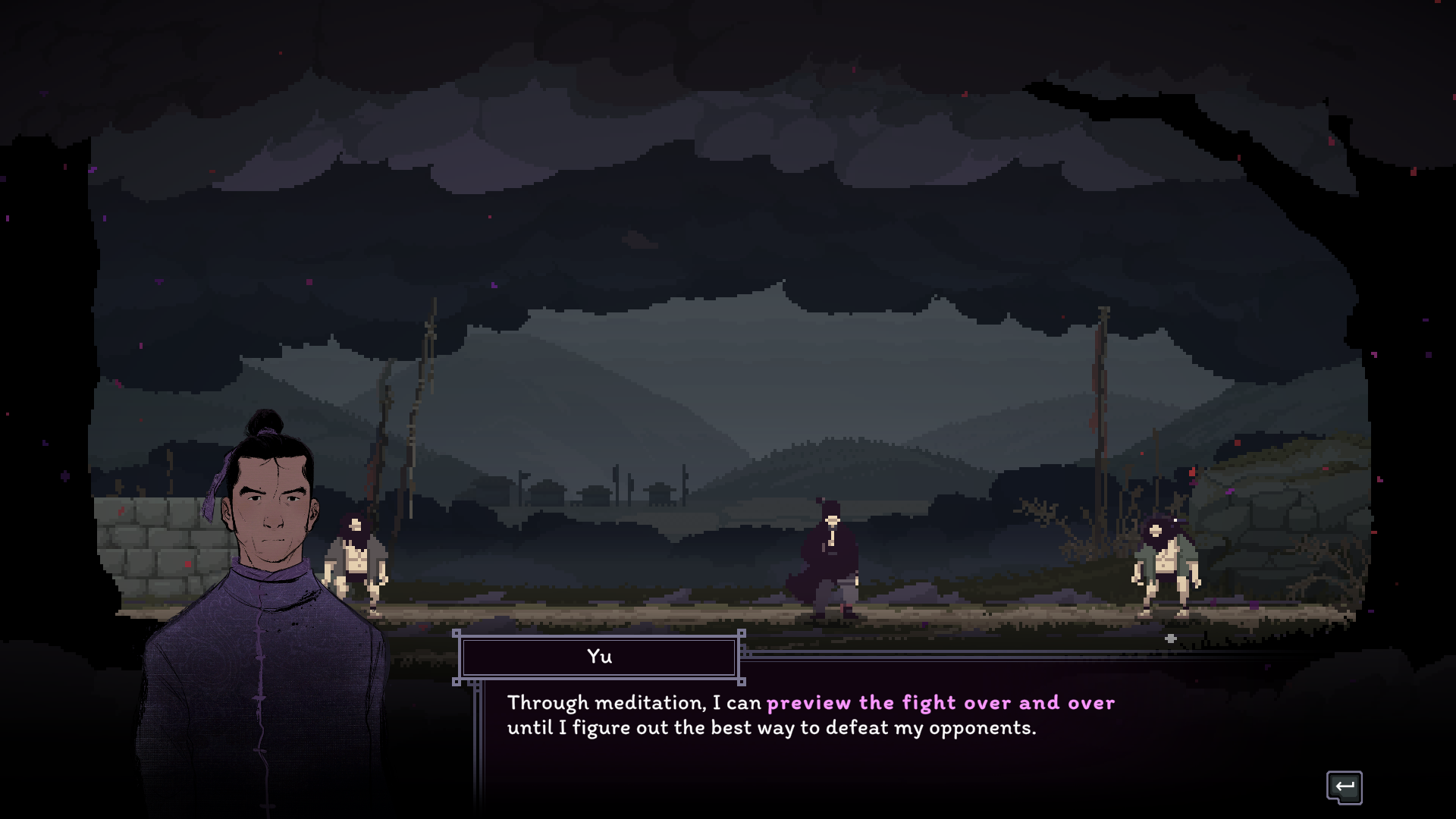
As we fight more peasants, one of the masters of Foresight, Talgun, a short, easygoing old man, appears before us in one of our pre-fight premonitions. He teaches us a little more about the game’s combat and alludes to much change happening in our absence. You see, the Order of Foresight’s sacred mission is to protect the Emperor, but the Emperor of the Lun Dynasty has fallen under the control of a foreign mercenary called The Admiral. The foreigner is a skilled, deceitful politician who has gained substantial influence in the palace’s court, and it’s now up to us to stop him.
Eventually, after progressing further into the countryside, we make it to another master of Foresight, Ogai. It soon becomes clear that he’s now working against the order and commanding the drunken peasants who attacked us. Before we can even fight him, he takes us out. We wake up in the monastery and meet Pakun, one of the keepers. We then go and greet Talgun face to face, and he gives us more insight into the Foresight as well as his technique, the School of the Leaf, which rejects violence.

When we’re done looking around the monastery, we can head out through the Moongate and begin our first run. Our goal is to make it to the Celestial Palace to save the Emperor, and to achieve victory, we must fight our way through four stages. The four stages include the Countryside, the Mountains, the Capital, and the Celestial Palace. To clear each stage, we’ll have to survive various combat encounters, each of which bears different rewards, with each stage culminating in a boss fight.
The usual combat encounter will have a few different enemies for Yu to contend with, and thanks to the Foresight, you can fight enemies again and again until you feel confident. Each enemy has a specific moveset, which is mostly static. There are basic pawn enemies, who will simply try to strike or throw something at you. Pawns are easy to take care of. Where the real meat of the complexity comes from is the various “resources” that both Yu and certain enemy types can have. The two big resources are dodge and block. Dodging allows the player to slip past an enemy's attack while the attacks continue on their path, possibly hitting another enemy if you are positioned well. Block outright prevents taking damage from an attack and provides the player with time to counter (enemies will automatically counter after they block). These resources are represented by small shapes above either the player's or the enemies' heads. There’s a blue circle for dodge, a yellow square for block, and a green triangle for a special move, which only the player can use. These resources disappear upon use, so players will have to deploy them carefully.

The entire battle revolves around how you disarm enemies who have these resources before they become a problem. Between the strategic combat, automatic reactions, and enemies with names like “pawns” you would think this game is turn-based, but fights happen live. Though, the path to victory is so procedural at times that it can feel turn-based at times. Plus, there’s no option to dodge or counter outside of having a resource for those actions, and enemies attacks have a sort of lock-on effect, so one could say that turns happen during real-time combat.
At the start of the game, the only school of Foresight available is Master Talgun’s School of the Leaf. This school emphasizes dodging and letting enemies take care of each other. After a few runs, you’ll meet stern Master Nodai, and you’ll gain access to his Cold Eye technique, which is all about blocking and retaliating in kind. Then you meet Master Onya, whose school of The Storm focuses on precise attacks to decisively remove opponents from the board. Next up is Monkey, who’s not really a master of Foresight; he’s just a wild man who trespasses on monastery grounds and fights like a monkey. The humble Yu takes note of this fighting style, adopting drop kicks and trickery under Monkey's influence. Finally, there’s Yu’s childhood friend, Buton, and her Tiger fighting style, which dishes out devastating special attacks that keep Yu mobile. After the first fight of every run, players can choose a starting technique from their chosen style. In addition, choosing a fighting style and master before a run will affect which in-run upgrades you have access to, which uses the familiar ‘pick-one-of-three’ rogue-like system to gradually augment your moveset. Players will also unlock new techniques as they progress through the game with the various masters/teachers.

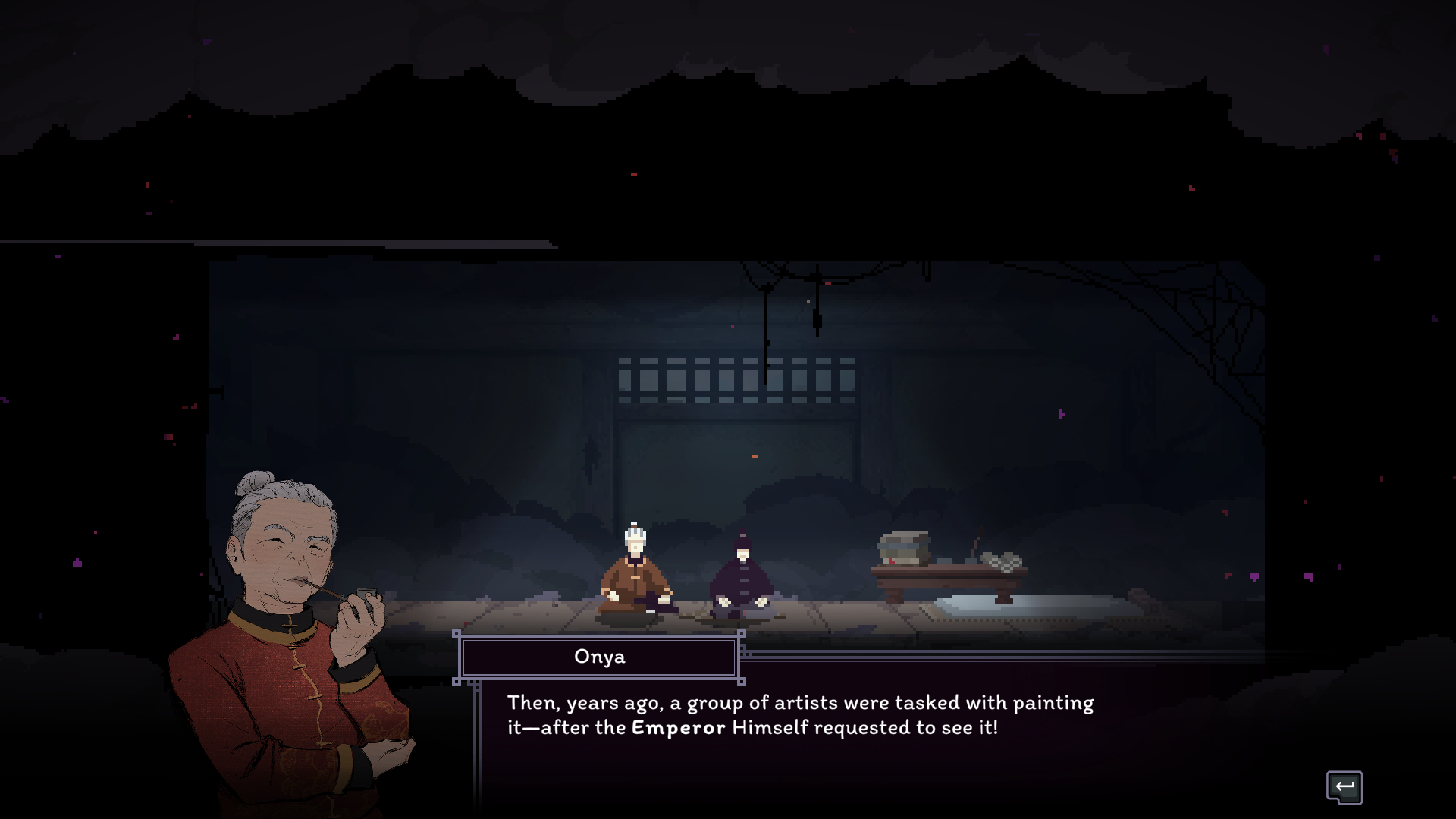

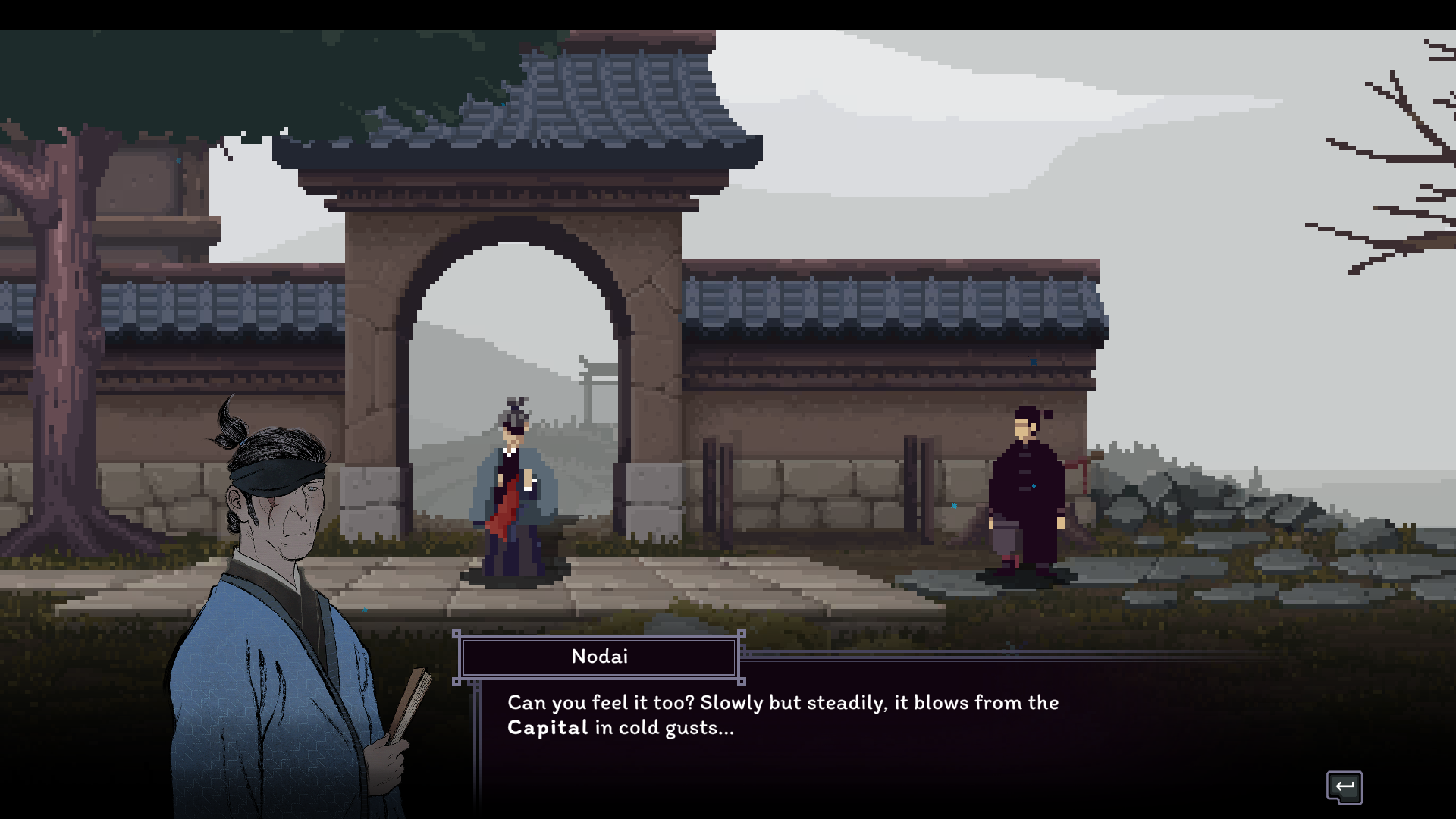
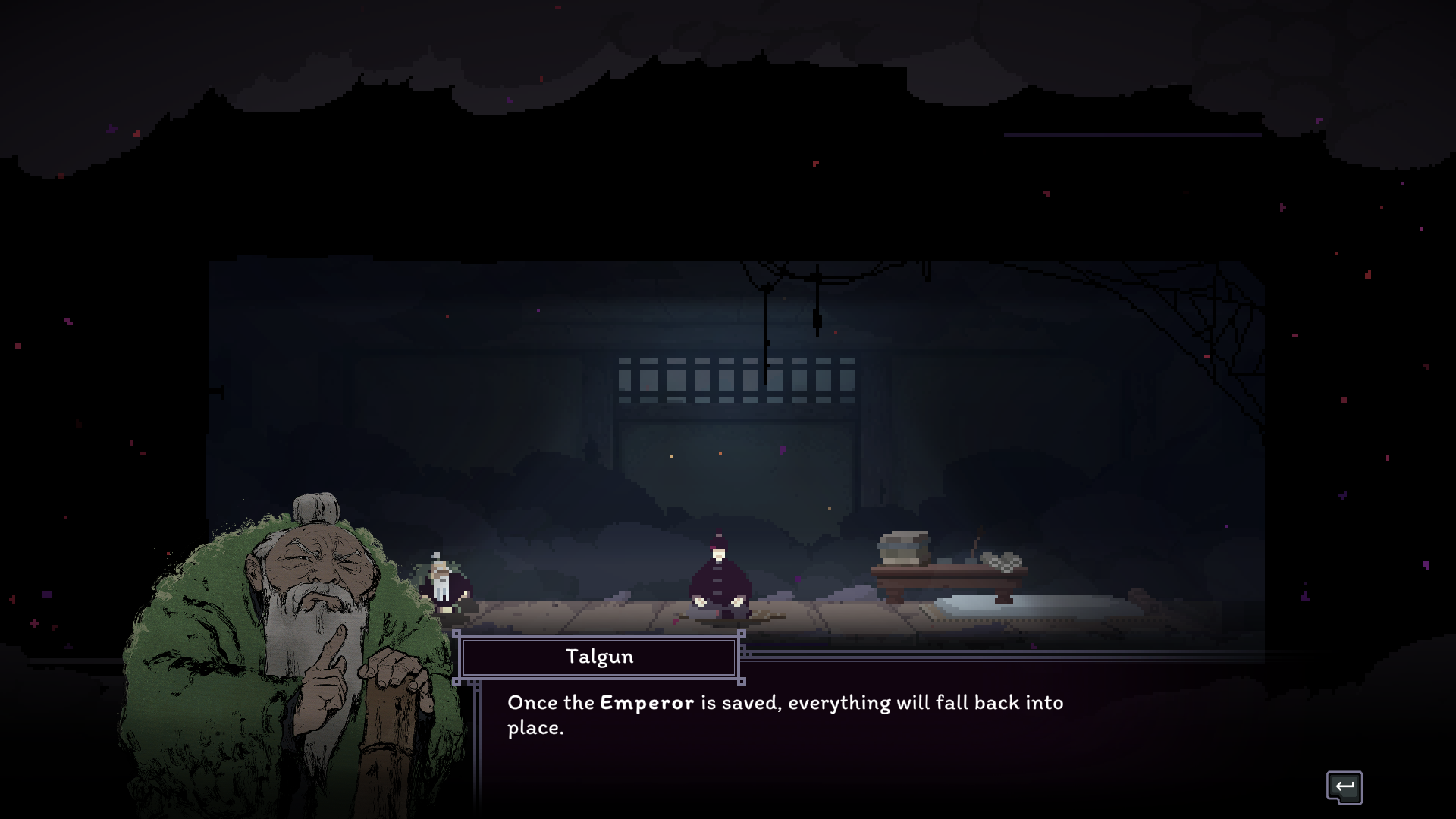
The dynamic between the player and enemies is quite intricate. Your goal is to use the resources you have to defeat all enemies, but precision is key. Any minor mistake will result in receiving damage, which is a grievous misstep in a game where you only have three health. After every encounter, you gain rewards, like gold to spend at shops and a new technique. Some fights might have you go in without using Foresight, but your reward will be a rare technique. Other times, you’ll be able to fight a Master of Foresight to gain one of their techniques, creating combos with the Master you chose at the start of the run. Other battles will have you protecting a smuggler who’s still loyal to the order, granting you a hefty sum of gold, but if the smuggler is defeated, then your run will end. I personally dislike that last one, but the beauty of the system is that you can choose from a few different paths to progress. You’ll also get bonus objectives, like “Cause an enemy to miss an attack” or “Defeat all enemies in 8 seconds.” If you’re successful, you’ll be granted additional gold to use at shops or a lotus petal, and if you collect five petals, you’ll be allowed to revive upon defeat.
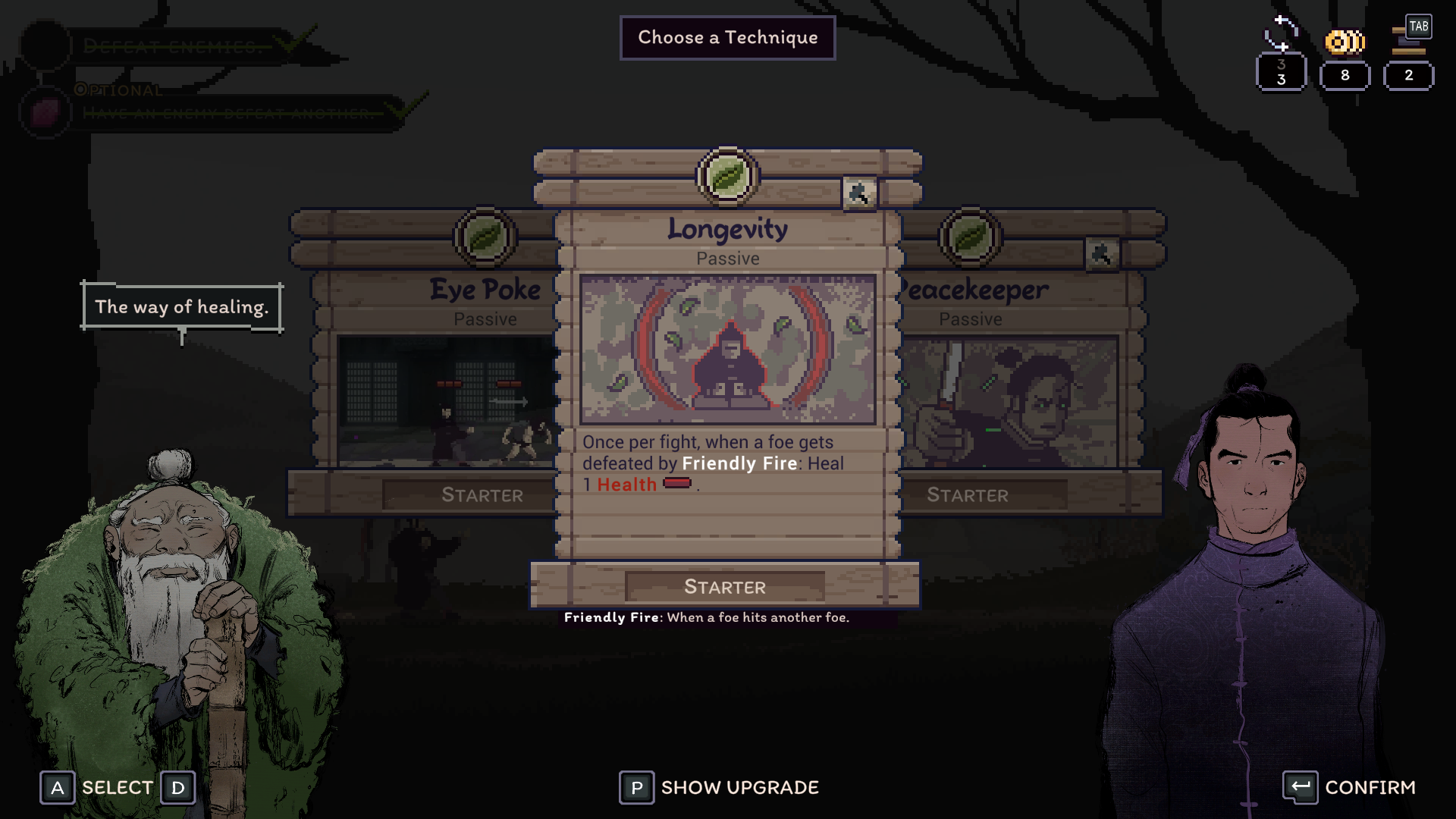
Once or twice per stage, you’ll run into a shop that will let you exchange your hard earned gold for health in addition to either techniques or trinkets. Trinkets grant a few effects, like a scroll that instantly gives you a technique from a certain Foresight master, or removing health from enemies before a fight, or temporarily removing your health in exchange for more later. Some of them are game-changing, but a lot of them are underwhelming and too niche to offer consistent value. I suggest avoiding the Foresight technique scrolls. They often give you a technique that’s completely useless when taken out of the context of their master’s move set, and will sometimes completely screw up your run. I once bought a scroll from Nodai’s Cold Eye school, and it gave more enemies a block resource, literally ruining my run and making it a guaranteed loss. That being said, shop areas also present you with the option to sacrifice two techniques for one of a higher rarity, so if a technique doesn’t instantly ruin your run, you can sacrifice it later.
This brings me to this game’s biggest weakness: its cruelty. Forestrike isn’t just difficult, it’s straight-up unfair at times. Sometimes, enemies would simply have more resources than I could deal with, even when I play the situation perfectly, resulting in me taking damage. This is a game that both demands perfection and then punishes you anyway. It feels cheap. For example, at one point I had an enemy with a block to my left, behind him was a rock-throwing pawn, and even further an enemy who, if left unhit for too long, gains shields and a two damage attack. This meant I had to use my block on the first enemy to stop his counter attack, and by the time I got to the final enemy, I had no way to counter their attack. I could not escape this situation without losing two health, which is insane for a game that starts you off with three.

Another time, the game spawned me in front of an enemy with a musket and a shield, meaning they could take one free hit without damage or staggering. He shoots immediately, meaning I could not approach him without losing 2 health. I could backflip off the wall behind me to dodge the bullet, but then he charges, and given that he has a shield, there’s no way to avoid the follow-up attack. Each fight feels like a game of chess, but sometimes you start in checkmate. The side objectives are the same way, sometimes putting those vital rewards out of reach, thus hampering your run even further. Occasionally, you’ll do the side objectives perfectly, and then need to waste the extra gold you earned on health because the game forced you to take damage. The game is making you jump through flaming hoops just to burn you anyway upon success.
What rubs salt in the wound is that each defeat is met with a deluge of screens you have to get through before your next run. Some are just nice animations, some show you your progress, and others are just loading screens. I counted six screens and animations in total in order to get back to the monastery, and then to get into a new run, there are about six more. Of course, many of these serve a function like choosing your technique, but others are just slow animations, so I think they could remove a few. What’s funny is that some are skippable by pressing escape and others by pressing space bar, so you get used to spamming them to cut down on the waiting time. The problem is that important choices, like choosing your path or choosing if you want to use a lotus to revive, are also attached to the space bar. That means you might accidentally choose a path you didn’t want or revive when you wanted to save your lotus. I feel like the default option for the lotuses should be “don’t use,” and choosing paths should have the same option.
That being said, when the game works, it works well. There’s something so thrilling about planning out your strategy and backup plans and executing them perfectly. The game even gives you a post-fight rewind, complete with a pause, play, and scrub feature so you can watch your moves play out. The animations and sprite-work are simply excellent, and I was never left guessing about an enemy’s attack range. It’s all telegraphed well. Beyond the function, there’s an abundance of beauty everywhere you look. The monastery and countryside are run-down and overtaken by nature, using a lot of greys and murky greens to illustrate that. The hand-drawn character portraits are expressive during dialogue, and they do a great job of reflecting the characters' personalities. Master Nodai might be my favorite of them all, with his cold, guarded demeanor occasionally contrasted by outbursts of fervor, revealing the bottled rage that shapes and fuels the Cold Eye technique. I personally enjoyed talking with all of the characters, and story moments felt impactful and well-paced, which is hard to achieve in a rogue-like. The sound design is also quite excellent. Punches and kicks sound meaty, lending weight to the combat. The background ambiance fits the zones, like the bugs chirping in the countryside. The music is traditional, with lots of string instruments to hype you up during the battles.
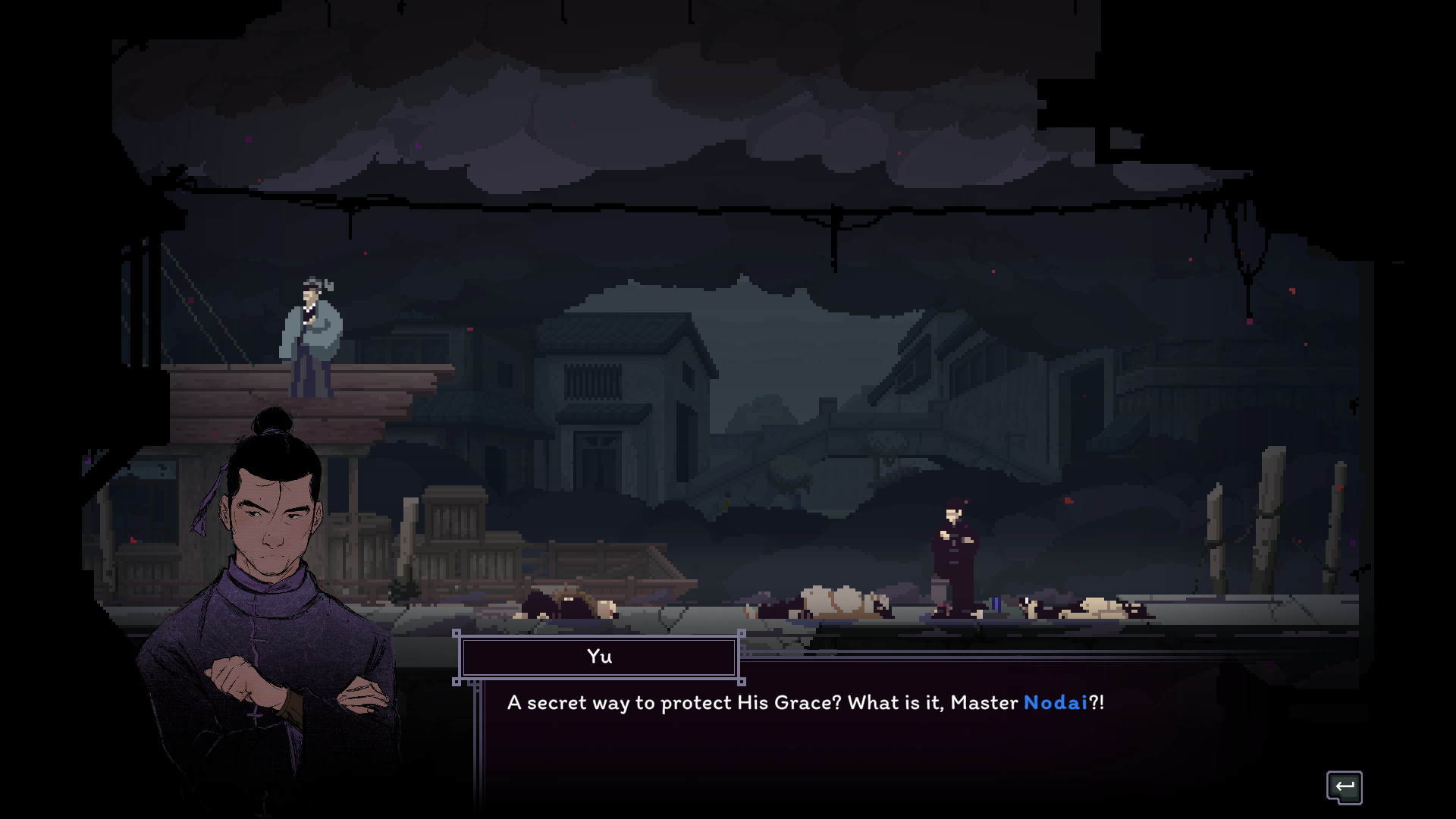
Overall, I quite enjoyed my time with Forestrike, though its glaring balance problems hampered that enjoyment more than once. While the art, sound, and story are all exceedingly well done, the fights can feel clunky, leaving the player to feel like they’re at the mercy of RNG and the resource system. I would recommend any rogue-like fan look into this game, but maybe wait for a sale to snag it.
Forestrike
Good
Forestrike is an action rogue-like where players can practice every battle before it occurs by using the Foresight. This system in and of itself is fun, but the game can’t get out of its own way with unfair balancing that punishes the player regardless of performance. Even so, when the gameplay works, it works wonderfully, with an excellent sense of aesthetics and a strong story and characters to back it up.
Pros
- The foresight system is fun and unique
- Great aesthetics
- Strong characters and story
Cons
- Poor balancing
- Number of screens could be streamlined
This review is based on a PC copy provided by GamingTrend.
